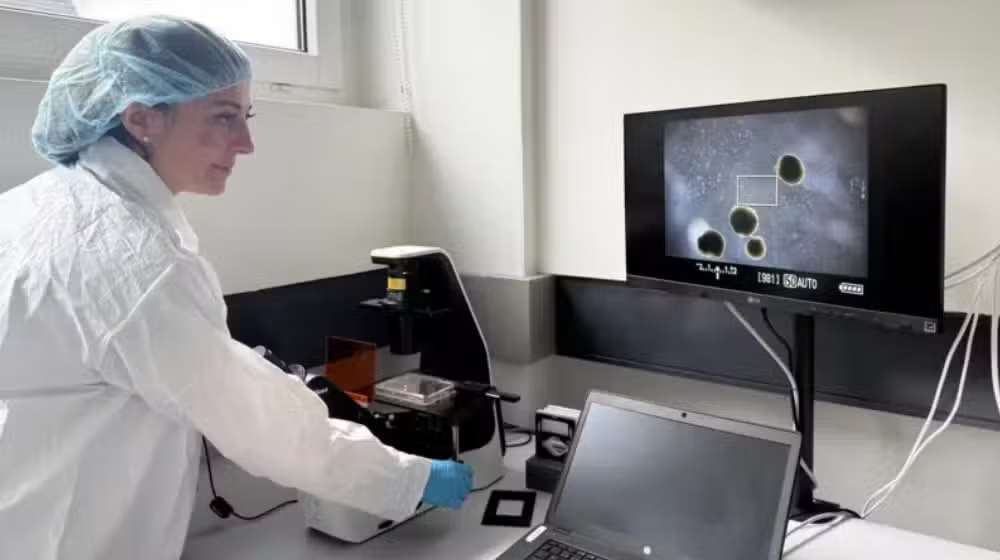In a groundbreaking development, scientists in Switzerland have taken a giant leap toward merging biology with technology through the creation of biocomputers made from living human cells. The project, led by researchers at the FinalSpark lab, has captured global attention for its potential to revolutionize computing, artificial intelligence (AI), and medical research. These living systems, often referred to as “wetware,” could transform how we process data and design computers in the future.
What Are Biocomputers Made from Living Human Cells?
Biocomputers made from living human cells represent a fusion of biological science and computational technology. Unlike traditional silicon-based systems, these biocomputers rely on living brain-like structures known as organoids, which are grown from human skin cells. These organoids are clusters of neurons capable of sending and receiving electrical signals.
At FinalSpark, scientists are using electrodes to connect these neurons, enabling them to perform basic computational functions. Essentially, these organoids act as tiny living computers, capable of learning, adapting, and processing information in ways that mimic the human brain.
The Science Behind Biocomputing
Each organoid used in the Swiss lab contains thousands of neurons that can communicate through electrical impulses, much like a real brain. By connecting them to a network of electrodes, researchers can stimulate the organoids and observe how they respond. Over time, these responses begin to form recognizable patterns, suggesting that the neurons are capable of basic learning and memory formation.
Dr. Fred Jordan, co-founder of FinalSpark, describes these systems as “the next evolution in computing.” He explains that biocomputers made from living human cells could one day power advanced data centers, providing faster learning and drastically reduced energy consumption compared to traditional hardware.
Energy Efficiency and Environmental Impact
One of the most promising aspects of biocomputers is their energy efficiency. Traditional data centers consume massive amounts of electricity to process information and keep hardware cool. In contrast, biocomputers require only a fraction of that energy, since neurons operate at extremely low power levels.
According to FinalSpark’s early research, neuron-based systems can process information at up to a million times more energy-efficient rate than digital processors. This has led scientists to explore biocomputing as a sustainable alternative to power-hungry technologies, aligning with global efforts to reduce carbon emissions in the tech industry.
Challenges of Growing Living Computers
Despite the excitement, creating biocomputers made from living human cells comes with significant challenges. The organoids must be kept alive in a laboratory environment using special nutrient-rich fluids. Because they lack blood vessels, their lifespan is limited to about four months.
Maintaining their health and stability is a delicate process. Researchers must constantly monitor their temperature, oxygen levels, and nutrients. Dr. Jordan acknowledges that these biological systems are “fragile but full of potential.” Scientists are working on developing techniques to extend their lifespan and improve the complexity of neural connections.
Global Research on Biocomputers
Switzerland is not alone in this pursuit. Similar biocomputing projects are underway in Australia and the United States, where scientists are training brain-cell organoids to play simple computer games such as Pong. These experiments are helping researchers understand how neurons learn, adapt, and make decisions — crucial steps toward developing functional biocomputers.
In the US, the Johns Hopkins University Biocomputing Initiative is exploring how organoid-based systems could be used to simulate neurological diseases like Alzheimer’s and Parkinson’s. By observing how neurons respond to different stimuli, researchers hope to uncover new ways to test drugs and study brain function without relying on animal testing.
The Role of Biocomputers in the Future
Experts agree that biocomputers made from living human cells will not replace traditional silicon-based computers anytime soon. Instead, they are likely to complement existing technologies, offering unique advantages in areas where human-like learning and adaptability are required.
For example, AI systems powered by biocomputers could one day think and learn in a more natural and efficient way. Medical researchers might use these systems to simulate patient-specific conditions, accelerating personalized medicine. Moreover, industries dependent on high-performance computing could benefit from reduced energy costs and improved processing speed.
Ethical and Philosophical Questions
As with any groundbreaking scientific discovery, biocomputers raise important ethical questions. Because these systems use living human cells and exhibit neuron-like activity, scientists must carefully consider how far they can go in replicating human cognition. The possibility of consciousness, even at a rudimentary level, adds complexity to the debate.
Researchers like Dr. Jordan emphasize that their work focuses strictly on advancing technology, not creating sentient beings. We’re building computers that actually think — using living cells,he said, highlighting the balance between innovation and ethical responsibility.
The development of biocomputers made from living human cells marks one of the most exciting frontiers in modern science. By merging biology and technology, Swiss researchers are paving the way for more energy-efficient, intelligent, and sustainable computing systems. While the technology is still in its early stages, the potential applications are vast — from revolutionizing artificial intelligence to reshaping the future of medical research.
As the world continues to seek greener and smarter solutions, biocomputers stand as a symbol of what’s possible when science dares to think — and grow — outside the silicon box.



